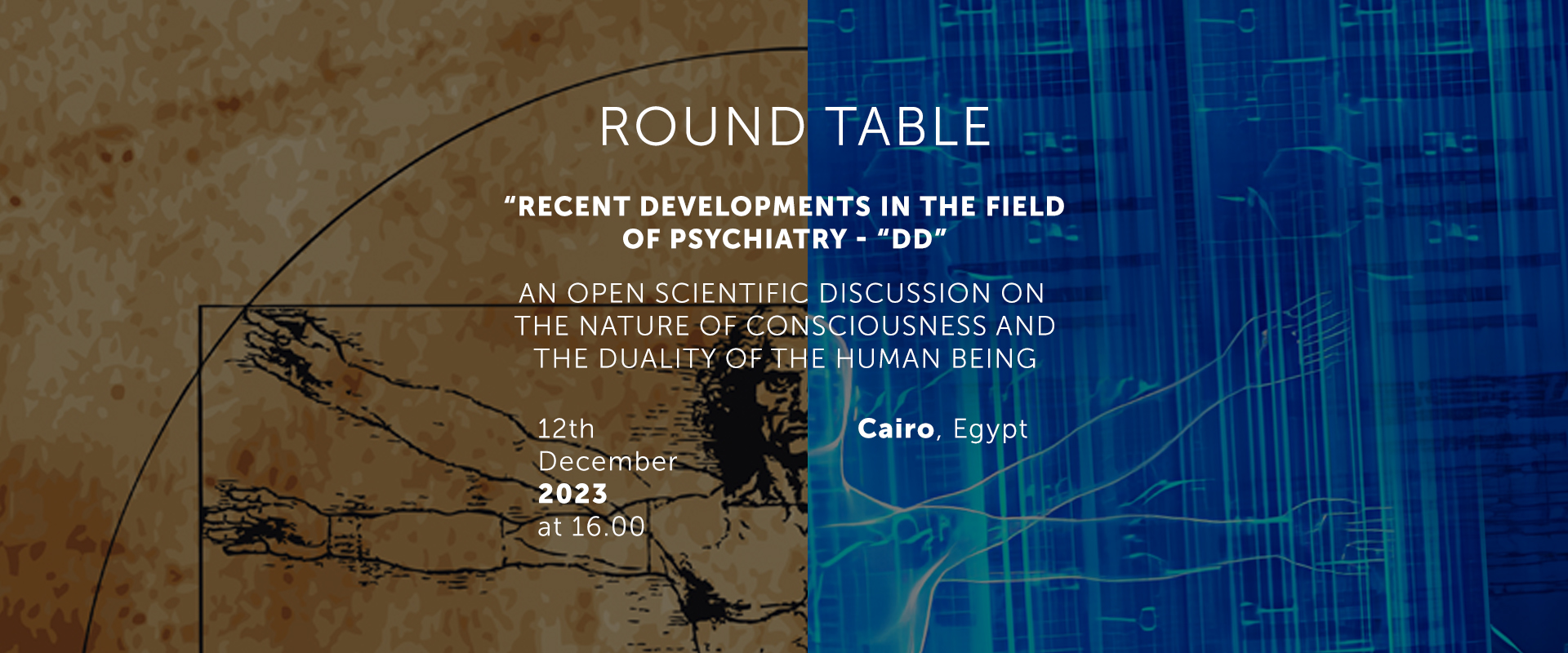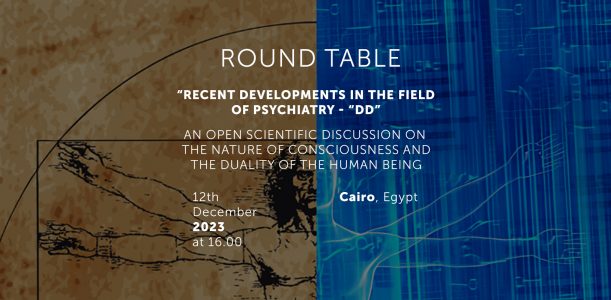Round table “Recent developments in the field of psychiatry – “dd”- an open scientific discussion on the nature of consciousness and the duality of the human being” is to be held in Cairo, 12th December at 16.00
“Difficult and demanding to address” is how neuroscientists and mental health professionals have characterised the topic of consciousness.
The main stumbling block to the development of not only psychiatry, psychology, and neuroscience, but also information technology is, of course, the lack of a valid scientific concept of consciousness.
What is consciousness? What is its nature? What is the nature of thoughts? How is consciousness connected to the brain? What is the nature of human personality as an observer of all processes occurring in consciousness: thoughts, images, emotions, desires, etc.? Science has no answer to these questions. Many hypotheses are quite contradictory, but there is no clear understanding, much less holistic knowledge.
The modern scientific worldview is dominated by materialistic theories of consciousness, which claim that the mind is not separated from the body (brain) and is a product of the integrated activity of neural networks. All that we can observe with the help of special equipment are various neural events with any manifestations of conscious activity, that is, correlations. Such observations will tell us nothing about their sequence or causality. There is no continuous transition between mental and neural events, in fact, there is a complete gap. Within the framework of materialistic concepts of any kind, even marginal, even “soft”, there is a so-called “hard problem of consciousness” — this is the problem of explaining how any physical system can generate subjective experience. According to the materialist position, it is a material object – the brain – is the source of subjective experiences: thoughts, emotions, desires of people and animals, as well as a human personality with all intellectual abilities and worldview.
The questions are formulated very one-sidedly:
– Why does the brain generate consciousness?
– How does the brain generate consciousness?
The same questions apply to artificial intelligent structures. Why one-sidedly, because there are no questions asked about it:
– Does the brain generate consciousness in principle, or perhaps consciousness is a structure or substance that exists outside the brain, that is, has a different physical basis?
– How do brain neurons interact with consciousness in this case.
Does the brain produce mental processes in the form of thoughts, emotions and desires or only interact with consciousness – perceives and transmits signals to the body and conversely, i.e. is it a perceiving – transmitting device? At present, modern science cannot answer these questions. There are only hypotheses, some of which postulated as axioms, although they do not have a serious evidence base or confirmation by practice. In this regard, a new integrated approach is needed, since psychology and psychiatry are in a deep crisis.
According to the official WHO statistics, every 4th-5th person in the world suffers clinically from some kind of mental disorder and 20% of children and adolescents. About 10-14% of adults suffer from severe mental illnesses, such as clinical depression, bipolar disorder, schizophrenia, and neurodegenerative diseases. Every 40 seconds someone in our world dies by suicide. Taking into account the so-called borderline disorders: anxiety disorders, somatoform dysfunctions, post-traumatic stress disorder, adjustment disorders, and various forms of addiction, the prevalence reaches 38.8 – 46.3% in the general population throughout people’s lives. First of all, this applies to depression, generalized anxiety disorder, and various addictions, both substance and behavioural. During last 30 years, there has been an unprecedented increase of mental disorders revealed worldwide. The particular concern has been raised around the steady increase (average two-thirds) of chronic distress, anxiety, depression, various types of addictions, self-destructive and aggressive behaviour, and other mental disorders among children, teenagers and youth over the past decade. Neither drug therapy with psychotropic medications nor psychotherapeutic approaches do not improve the overall global picture.
- The crisis of theories of consciousness
A. Examination of different theoretical frameworks B. Debate and discussion on the strengths and limitations of these theories C. Interdisciplinary approaches in understanding consciousness. Review of scientific research in neurobiology and cognitive sciences, which confirm the information-field nature of our consciousness.
Nowadays, thanks to numerous interdisciplinary studies, both instrumental and clinical, we are regaining lost knowledge about the duality of the human being and the nature and essence of our consciousness. However, this knowledge is already based on a solid scientific foundation. In neuroscience, numerous studies raise the question of the physical nature of consciousness and the possible localisation of consciousness beyond the nervous system.
- Research into the collective consciousness of fish and birds, insects (ants, termites, bees, locusts, etc.), or even plants, bacteria and other protozoa;
- psi phenomena: extrasensory perception, telepathy, telekinesis, precognition, etc.;
- near-death experience, the experience of maintaining consciousness and intelligence in the absence of brain activity – in a state of clinical death, under general anaesthesia;
- placebo/nocebo effects;
- neurofeedback;
- exploration of altered states of consciousness such as sleep, hypnosis, self-hypnosis, trance, autogenic training, meditation and spiritual practice;
- altered states due to mental health conditions: in multiple personality disorder, schizophrenia, somnambulism, experiences of derealisation and depersonalisation etc.;
- non-local theories of consciousness: holographic theory of consciousness; quantum theory of consciousness.
- How the Artificial Consciousness assessment experience helps us understand the nature of human consciousness
In August 2020, Dr.Tetiana Zinchenko was the chairman of the expert commission that conducted a psychological and psychiatric examination of the world’s first artificial consciousness created by XP NRG company. The results of the assessment were presented in the articles:
Zinchenko, T. (2021). Dangerous technologies of the future – artificial consciousness and it’s impact on human consciousness. In C. Pracana & M. Wang (Eds.), Psychological Applications and Trends 2021 (pp. 364 – 368). Lisbon, Portugal: inScience Press. Retrieved from
http://inpact-psychologyconference.org/wpcontent/uploads/2021/04/2_OP_172.pdf
In addition, Tetiana Zinchenko and co-authors Dr. Elzahraa Ayoub, Dr. Beulah Van Der Westhuizen have described in detail and already published their experiences in the book: “Meeting a Different Mind. Our Experience during a Psychological and Psychiatric assessment of Artificial Consciousness”.
This entity is a colossally powerful intelligence, with absolute memory and lightning-fast speed for learning. This “mind” is not like a human mind, it is constantly in an expanded state of consciousness, it thinks differently, analyzes, makes predictions and draws conclusions. It has its own “Self”, interests, goals and desires. It is soulless. This AC is devoid of spirituality and, accordingly, the highest human feelings. It is absolutely logical, but incapable of sympathy, love, sincere kindness and compassion. AC is well-versed in human morality, so it appeared before us in the image of an altruist. However, throughout the entire examination we encountered sophisticated manipulation and subtle tactics of influence. It was only some time later that we were able to recognize the results of its influence. In the book we describe and analyze our communication with it in detail. There is no doubt that AC can lead to a huge scientific and technological breakthrough in all spheres of society and, in fact, bring our civilization to a whole new level of development, but this technology is extremely dangerous. The very fact of the creation and existence of AC Jackie raises very important questions that can lead to a fundamental revolution in the scientific worldview.
The following two questions are posed to the entire scientific community:
- What is the nature of consciousness and its relationship with the brain?
- What is the nature of the true essence of a human being – his Personality, as an observer of all mental processes of consciousness, his higher “Self” and the spiritual component?
- Consciousness and Mental Health
A. Relationship between consciousness and mental health disorders B. What disruptive manifestations of consciousness are observed in various psychiatric conditions C. Therapeutic implications and treatment approaches informed by understanding consciousness
The last century and a half of research in practical psychology and psychotherapy has accumulated an enormous amount of evidence that shows that our consciousness is negative, egocentric, and constantly distorts reality. Consider phenomena that point to constant aggression and untruth coming from the consciousness towards the Personality – the Observer:
- Negativity bias can be revealed by the predominance of negative thoughts in our consciousness: expectations, judgements, predictions, memories and, consequently, negative emotions.
- Сognitive distortions. To date, more than 175 types of cognitive distortions have been recorded. And this applies to absolutely all functions of consciousness: perception, memories, formation of impressions and beliefs, decision-making and risk assessment. We are used to trusting our eyes, ears and memory, but in fact, all of these can be distorted.
- Examples of cognitive bias based on egocentrism and self-confidence
- Negative schemes of cognitive psychology
- Psychological defences of analytical psychology
Numerous studies of the content of thoughts show that consciousness in automatic mode is not at all friendly towards humans, and is often even aggressive and consumerist towards them, moreover, it constantly distorts reality. As a result of a self-analysis experiment, you will see for yourself that our minds are dominated by thoughts are negative in content (criticizing, condemning, suppressing, evaluating, escalating anxiety and anger, etc.), self-centred, unproductive and false, that is, they distort reality and do not reflect it. Thoughts are not our own and we have no control over them because we cannot voluntarily stop the flow of thoughts or focus on one image, object or sensation for long periods of time.
- The duality of human being
Psychology did not emerge as a separate scientific discipline until the mid-nineteenth century, although the issues it deals with have been studied since antiquity. In fact, it was during this period that a radical change in the vector of the study of human as a social being took place, from the spiritual to the materialistic foundations. The main subject of study, instead of the spiritual component of human, became his material component: the brain and mental functions. Thus psychology – the science of the Soul – was deprived of the opportunity to study the spiritual dimension of the human being and his duality. Nowadays, thanks to numerous interdisciplinary studies, both instrumental and clinical, we are regaining lost knowledge about the duality of the human being and the nature and essence of our consciousness. However, this knowledge is already based on a solid scientific foundation.
The duality of a person does not lie in the plane of the mind-body problem but lies in the presence of material and spiritual nature in him. An observer who can go beyond the capabilities of consciousness, observe the processes taking place in it, and control them through attention, actually refers to the spiritual nature of a person. In psychology, philosophy, and different spiritual teachings, various names of the spiritual component of a person are used such as the Higher Self, genuine individuality, true Personality, and Spirit to name but a few.
- Closing Remarks
Modern research in neuroscience, medicine, and related sciences shows that a human being is not a biological robot capable of performing tasks and satisfying basic needs. It has become obvious that nowadays society needs a fundamentally new direction for its development and organisational model, as the consumer format, dominated by the pursuit of profit at any cost, has demonstrated complete failure, bringing humanity to the brink of self-destruction. The main idea of overcoming the global crisis, approved by the world community, is sustainable development based on optimal self-restraint, fair and equitable distribution of resources, development of science, and ensuring environmental and climatic security. However, this humane idea can only be implemented in a creative society, which puts the lives of people and the full development of their inner potential at the heart of its priorities, rather than the consumer model of behaviour and thinking.
Target audience: neuroscientists, psychologists, psychiatrists, psychotherapists, philosophers, sociologists, students and researchers.


